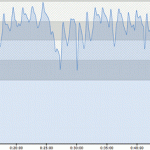What are training zones and why do they matter? Watching your heart rate as you exercise can help you get the most benefit from the time you take to exercise. Having a heart rate monitor gives you the ability to focus your efforts. I use a Garmin FR60.
Training Zones Defined
Zone 1Healthy Heart50 – 59% |
This is the beginning zone to help build health. While exercising in this zone is great for your heart it |
Zone 2Recovery or Fat Burn60 – 69% |
This zone is where most fat is burned and is great for recovery from harder work. A slow jog is a |
Zone 3Aerobic70 – 79% |
Here is where your system is working best to deliver oxygen throughout your body. Now your body |
Zone 4Anaerobic80 – 89% |
no pain, no gain – that saying comes from working in this zone. At this level your body can no longer |
Zone 5Red Line90 – 100% |
Just like an engine, running past the red line can’t be sustained. Training in this zone develops speed and |
Calculating Your Training Zones
There are two heart rates that you need to determine your training zones: your resting heart rate and your maximum heart rate. Calculating your resting rate is easier, while your maximum is a bit more of a challenge.
Resting Heart Rate
The best advice I’ve found to determine your resting heart rate is to go lay down for 20-30 minutes with your heart rate monitor on, then see the lowest rate that was recorded. Another recommendation is to measure your heart rate as soon as you awake in the morning.
Maximum Heart Rate
Determining your maximum heart rate is another topic all together. If you haven’t exercised, or have any possible risk of heart problems, check with your doctor for advise. Pushing your heart rate can be dangerous and should not be done without understanding the risks associated.
Your maximum heart rate is just that, the maximum rate that your heart can pump when you are exerting yourself as much as you can; to your maximum effort. That’s easily said, but no necessarily easily (or safely) done.
One of the most common statements about maximum heart rate is to calculate it by subtracting your age from 220. While that may work for some it can vary significantly for those that have remained active through their lifetime. With a little searching it isn’t hard to find many stories of people online who’s heart rates significantly exceed this general calculation.
There is quite a bit of research that would indicate your maximum heart rate varies from one form of exercise to another. For example running, biking, and swimming will have different limits to your body. For our intent of getting the most benefit from our exercise we should be calculating our training zones based on the type of exercise we will be performing. That makes this process even more challenging.
After quite a bit of searching the most recommended approach to determining your activity specific maximum heart rate (after getting your doctors approval, right?) is to do the following while monitoring your heart rate:
- 20 minute Build – Start slow the gradually increase your pace over 20 minutes. The goal is to gradually increase the amount you are working your body timed so you are working hard at the end of 20 minutes.
- 2 minute Sprint – Give all you’ve got! Sprint hard. If you are running or biking try to plan your route so you hit the base of a steep hill after 20 minutes and need to spring up the hill. The goal is to exert yourself all out.
- 10 minute Cooldown – You just pushed yourself hard, so take time to wind back down.
Now go back and check how fast you got your heart to pump during your sprint. In my own experience I find that my heart continues to climb while I’m sprinting, sometimes even hitting the max after my feet have begun to slow back down. This maximum is indeed just that your activity specific maximum heart rate.
Calculating Zones
So now your armed with two numbers, your rested, and you’ve exerted yourself in your favorite training activity. Time for some math. The percentages used to determine the training zones are not percentages of your maximum heart rate; rather they are percentages of your heart rate margin. The heart rate margin is the difference between your resting heart rate and your maximum; how much your heart can change in beats per minute.
So the calculation is rather simple:
HR = (MR – RR) * Percent + RR
Multiply your heart rate margin (max rate – resting rate) by the percentage you want to determine, then add your resting rate.
Many heart rate monitors have heart rate training zone calculators built in, but this give you all you need to determine your training zone. Now you can watch and shape which zone to keep your heart pumping in based on your training goals.





Want to discuss? Join the conversation CubeDwellerFitness's Facebook Page.